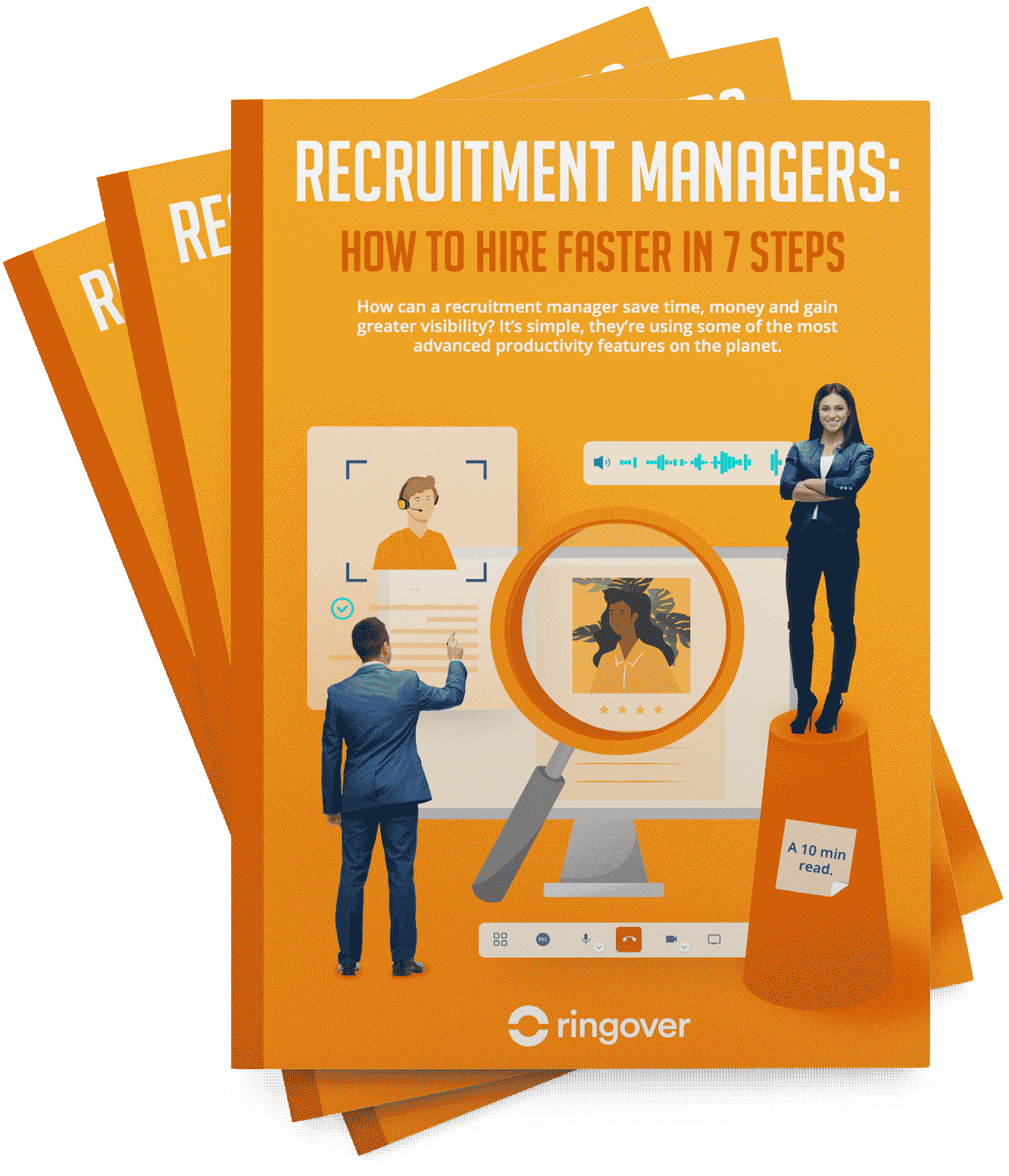Summary
Competition in recruitment is fiercer than ever in certain fields, and companies must employ methods to not only attract but also retain top talents. To gauge the effectiveness of these methods, it's best to use recruitment key performance indicators (recruitment KPIs).
Top 13 recruitment & staffing metrics to track in 2025
| Key Performance Indicator | KPI Description |
|---|---|
| Average number of applicants per job opening | Average number of application received per published job opening; this metric gives insight into whether candidates are attracted to a job and if the offer needs to be adjusted |
| Process duration | Average time necessary for the recruitment process from job posting to signing of a hiring contract |
| Conversion rate by acquisition channel | Understand how effective recruitment channels are by measuring the percentage of hires per acquisition channel over total number of applicants |
| Offer acceptance rate | Percentage of offers made and accepted, which reveals how attractive candidates find the company, and if there are issues throughout the recruitment process |
| Candidate satisfaction | Gather this information via satisfaction surveys to understand the candidate experience at various stages of the recruitment process |
| Turnover rate | Percentage of voluntary or involuntary employee departures over a given period, which can indicate retention issues |
| Average number of resumes per recruiter | Gives insight into recruiters' productivity and helps to distribute the workload |
| Number of calls and interviews per recruiter | To measure recruiter productivity by the total number of calls and interviews during a defined period of time |
| Average number of applications per departmentlevel | The number of applications received for a department or type of position (entry, senior), which supports a proper distribution of resources |
| Career site traffic | Quantity of visits to a career site, which reveals if it has a quality user experience and if the offers are appealing to candidates |
| Application abandonment rate | Percentage of candidates who began but never submitted an application |
| Cost per hire | The total cost incurred over the hiring process for one candidate–this metric indicates opportunities for cost optimization |
| Cost per departmentjob | Similar to the above metric, this KPI allows for the comparison of costs between job types or departments, and can inform cost optimization strategies |
KPI or Key Performance Indicator: A Definition
KPIs, or key performance indicators, are used to measure an organisation's performance against the strategic objectives it has set.
Tracking these indicators can reveal trends and assist you in:
- Identifying opportunities
- Making strategic decisions
- Optimising results
Why measure recruitment performance?
As mentioned earlier, measuring recruitment performance is necessary if you want to remain effective and sustain workforce growth and, indirectly, organisational growth.
But specifically, what areas and issues can you act upon? What are the main objectives of recruitment KPIs?
| Objective | Objective Description |
|---|---|
| Monitor recruitment effectiveness | Evaluate recruitment process performance, taking into account timelines, candidate quality, candidate experience, etc. |
| Ensure quality candidate experience | Verify candidates have a positive recruitment experience, which helps to strengthen the employer brand |
| Execute action plans | Find areas for improvement throughout the recruitment process, create and execute concrete plans to optimise results |
| Measure impact | Evaluate if actions taken have accomplished the strategic objectives, which allows for adjustments if necessary |
| Optimise costs | To deliver a great ROI, you'll need to find ways to reduce costs while delivering a quality candidate experience |
| Better adapt to job market shifts | Identify trends so that you can adjust your processes and approaches proactively |
| Retain talents | Retention helps manage your recruitment needs, so you'll need to measure the employee sentiment to assess their satisfaction |
The list of the 13 recruitment KPIs to track in 2025
Below, we've listed 13 recruitment KPIs to track in 2025 to optimise your recruitment process and achieve your goals. They'll also help you determine if you're on the right track or if you need to adjust your strategy.
1. Average Number of Applications per Job Opening ✅
This is the average number of applications received per published job opening. This KPI is a good way to assess candidate interest in a job opening and determine if adjustments are needed to attract more talent.
2. Process Duration ✅
This is the average time needed to finalise a recruitment process, from job posting to hiring the selected candidate. You can delve deeper by measuring the duration of each step of this process to identify steps to improve efficiency.
3. Conversion Rate by Acquisition Channel ✅
With this indicator, you can measure the effectiveness of your various recruitment channels. You'll then have better visibility into these channels and can more easily allocate resources.
The formula for calculation is as follows: (Number of hires by acquisition channel / Total number of candidates by channel) x 100

4. Offer Acceptance Rate ✅
This is the percentage of offers made by recruiters and accepted by candidates. It helps measure your company's attractiveness. It's calculated as follows: (Number of accepted offers / Total number of offers) x 100. A low acceptance rate usually indicates a problem in your process.
To address this, here are some suggestions:
Make decisions more quickly
Procrastinating too much can drive candidates away or prompt them to accept a competing offer. It's therefore important to communicate a reasonable deadline to the candidate and stick to it.
Improve the candidate experience
A rejection can be due to a problem with the candidate's experience. This could be a lack of communication throughout the process or a poorly structured interview. Check the relevance of recruiters' speeches and improve them if necessary.
Align with your competitors
A salary that doesn't match the remuneration applied in a given field can also explain a low acceptance rate. It's therefore important that you offer competitive salaries.
5. Candidate Satisfaction ✅
This can be measured using a satisfaction questionnaire with a rating scale to gather candidates' feelings about their experience. Ask questions about the different stages of your process to identify those that need improvement.
6. Turnover Rate ✅
This is the percentage of voluntary or involuntary departures of employees over a given period. It can be symptomatic of retention problems within the company. The formula for calculation is: (Number of departures / Total number of employees at the beginning of the period) x 100.
7. Average Number of Resumes per Recruiter ✅
In addition to informing you about the productivity of your recruiters, this KPI helps you allocate workload efficiently and identify any necessary reinforcements. To calculate it, use the following formula: Total number of CVs reviewed by recruiters / Total number of recruiters involved in the recruitment process.
8. Number of Calls and Interviews per Recruiter ✅
This data also informs you about the productivity of your recruiters. Thus, you can ensure the smooth running of your recruitment campaigns and adjust task allocation if necessary. It's the total number of phone calls and interviews conducted by a recruiter during a given period. You can obtain it using a business phone system like Ringover.
9. Volume of Applications per Department or Level ✅
This is the number of applications received for a specific department or level (junior/senior). With this KPI, you can adjust your efforts and resources for each sector.
10. Career Site Traffic ✅
This is the number of visits to the company's career site. You can obtain it using solutions such as Google Analytics. It informs you about the attractiveness of your company and the published offers. However, it's not a standalone decision-making tool because many parameters, including SEO, can impact your career site traffic.
11. Application Abandonment Rate ✅
This refers to the percentage of candidates who started filling out their application but did not submit it. To obtain it, proceed as follows: (Number of abandoned applications / Total number of applications started) x 100.
12. Cost per Hire ✅
This KPI encompasses the total cost of actions taken to recruit a candidate. It includes expenses related to job advertising, agency fees, administrative costs, etc. The formula to obtain it is: Total recruitment expenses / Total number of hires. With this KPI, you can more easily identify cost optimization opportunities.
13. Cost per Department/Job ✅
This metric is more precise than the previous KPI, as it allows you to compare recruitment costs between jobs or different departments of your company. Total recruitment cost for a specific department or job / Total number of hires for that department or job.
Ringover helps you improve recruitment KPIs
Ringover can support you in your recruitment activity in many ways and even help you improve certain KPIs. The cloud telephony solution accompanies you in achieving your goals by acting on three key points:
- Recruiter productivity
- Workload distribution
- Candidate satisfaction
- Collaboration and decision support
Improving Recruiter Productivity
The duration of the recruitment process and the number of calls made by recruiters. Indeed, Ringover includes features such as call campaigns and the power dialler. These are two tools that help increase productivity.
You no longer have to manually enter phone numbers or even search for them in your CRM, as Ringover offers integrations with popular CRM software like Hubspot, Salesforce, Zoho, and more. Just import the list of numbers to contact into your call campaign feature, and you're done. The power dialer will then automate the calls: a time saver for your recruiters.
Furthermore, Ringover includes a call script feature allowing you to integrate your recruitment interview scripts directly into your call campaign interface, ensuring the right conversation with key information for each interaction.
Better Distribute Workloads
Ringover offers an interface with analytics that inform recruiters' telephone activity.
The software can display call logs as well as phone KPIs and metrics such as call duration, outbound call volume per team or per recruiter, thanks to an advanced call routing software.
Thus, you can quickly view the workload of your recruiters and adjust your resources accordingly.
Candidate Satisfaction
Another advantage of Ringover is that the solution integrates seamlessly with ATS like Bullhorn, Vincere, Zoho Recruit, etc., and CRM software.
Thus, you can centralise your interactions on a single interface, and you no longer have to switch between applications to make calls or respond to candidates via email or instant messaging applications.
You can provide a seamless experience to candidates without ever losing track of your exchanges. Ringover also integrates a video conferencing tool for your remote video interviews.
Collaboration and Decision Support
Ringover includes a range of collaboration features. You'll find a chat to communicate easily with your recruitment teams, but also a system of customizable call tags and notes through which you can specify candidates to call back, talents selected for an interview, references, etc.
In addition, a call recording tool is also integrated by default if you want to listen back to certain conversations.
Finally, Ringover offers an additional feature of call transcription and automatic summarization, allowing you to access the entire content of telephone interviews or their summary in written form to quickly access the information you're looking for.
Integrating Ringover into your recruitment process offers multiple advantages to your team. In fact, it allows you to improve KPIs related to communication and productivity.
By optimising recruitment time, candidate experience, and employee productivity, you can increase your efficiency and achieve your recruitment goals more quickly while offering a quality experience to your candidates.
Take on the challenges that lie ahead and improve your recruitment KPIs by testing Ringover for free now!
Published on November 22, 2024.


